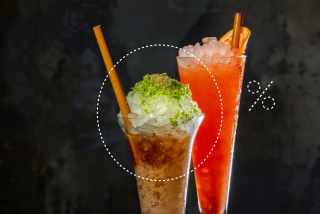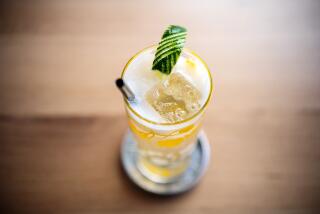Your no-drama drinking guide for the holidays
Ah, the holiday dinner table: scene of the highest highs (your family’s impromptu, multigenerational rendition of “Christmas Time Is Here” from “A Charlie Brown Christmas”) and the lowest lows (that time Meemaw found out you’re a socialist). This time of year is challenging enough without wine-fueled family drama, so I’m committing to a conflict-free Christmas — at least when it comes to the booze. To that end, I’ve developed a six-point plan to keep things merry and bright.
1. Start low-alcohol.
In the Timberlake household, drinking starts as soon as “the sun is over the yardarm.” This is supposed to be around 5 p.m., but I’ve noticed that it gets earlier and earlier every year. If we start with boozy cocktails or a big, 15% alcohol-by-volume wine, we’ll all be a mess before the spinach dip hits the table. The answer?
For the record:
8:55 a.m. Dec. 26, 2018An earlier version of this story described pét-nats as typically not goosed with yeast for a secondary fermentation; it should have said they are typically not goosed with sugar.
Pét-nats: They have bubbles, so they’re celebratory, but they’re also light enough to be “sessionable.” The name is a mashup of “pétillant” — meaning softly effervescent — and “naturel,” which is a much disputed term in wine, but in this case usually means that the wines are not goosed with sugar for a secondary fermentation, as is the practice in Champagne. One result of letting the wine finish fermentation in the bottle is the soft, playful mouthfeel. Another, particularly for our drink-planning purposes, is that the wines often clock in between 10% and 12% ABV.
Holiday gifts from the L.A. Times Test Kitchen »
Chëpìka’s Catawba is crisp, apple-y and 9.5% ABV. Bonus, it makes for excellent cocktail-hour conversation: “Yes, they make some lovely wines in the Finger Lakes region of New York; yes, Catawba is a grape variety native to New York; isn’t it delicious?”
That said, do not despair if you can’t find any pét-nats at your local supermarket or wine shop. Lou Amdur, owner of Lou’s Wine Shop in Los Feliz, recommends looking for a well-made crémant from a good grower. “They’re often made with as much care as their more expensive counterparts, and made using the same techniques, but because they’re not from Champagne are typically less than half or a third the price of an entry-level grower Champagne bottle.” He especially loves Château de Brézé’s Crémant de Loire brut, a bone-dry chenin blanc that is “like biting into a Granny Smith apple, if the apple had no sugar and was fizzy and lightly alcoholic. And a wine.”
Your third and easiest option is to bring back the white wine spritzer. Add white wine to a rocks-filled glass, top with seltzer, et voilà: It’s a cocktail, a glass of wine, and a glass at least half full of water. The best part? Very mediocre white wines can make very acceptable spritzers, so don’t feel like you have to get fancy. “I can’t tell you how many O.G. ‘spritzers’ I’ve consumed at subpar open bars or holiday parties,” says Talia Baiocchi, the editor in chief of online magazine Punch and author of “Spritz.” Add a dash of bitters and a citrus peel, and even a gas-station Chardonnay has a certain je ne sais quoi.
2. Choose a house white, and make it Chenin Blanc.
When your mom drinks only Chardonnay and your aunt drinks anything but Chardonnay, a dry Chenin Blanc such as Thibaud Boudignon’s Anjou Blanc will save you. At $45 a bottle, it’s a splurge, but it has never let me down. So beloved is Boudignon at Chez Timberlake, we even have a theme song. Actually, it’s just the “Pokémon” theme song, but instead of “Pokémon,” we sing “Boudignon.” I told you, we’ve been drinking since before 5 p.m.
If you can’t find Chenin from Boudignon (because I bought all of it), ask your favorite local wine shop for Chenins from the grape’s ancestral home in France’s Loire Valley. Producers like Domaine Huet, Domaine Bernard Baudry or Domaine Mosse (a favorite of Night + Market) are good bets.
3. Winter rosé: It’s a thing.
Rosé is the Channing Tatum of the wine world. (He can sing; he can dance; he can do comedy and drama; your grandma loves him, even though he was in a stripper movie.) Rosé is just as versatile.
“A lot of customers are experiencing rosé fatigue after drinking an ocean of the stuff during our beastly, heat-wave summer,” Amdur says. “I urge folks not to abandon rosé, but to switch to more structured rosé wines that pair well with savory, holiday feasts.” Substantial, not-too-fruity rosés are out there. Look for Clos Cibonne’s Cuvée Tradition, made in Provence from the grapes tibouren and renache. It’s aged in barrel with a light cap of yeasts, similar to a fino sherry or a Jura vin jaune, which gives the wine texture and a bit of salinity, making it a great match for seafood or poultry.
4. Skip big reds and buy big bottles.
Red wine is tricky. The Holiday Industrial Complex tells us that now is the time to pour that expensive bottle of Chateâuneuf-du-Pape or Napa Cab. And, sure, those wines can work with beefy main courses, but they can also be palate-killers. So ditch the usual suspects and opt instead for a bottle of Gamay, the classic wine from the Beaujolais region of France. “Beaujolais dovetails beautifully with traditional, bourgeois, stick-to-your-ribs homey French cuisine,” Amdur says. “Typically, the wines are high acid and low in tannin and extract, which is what you want when you’re gorging on fatty, earthy flavors.”
Find presents for all your loved ones. Browse by category or just click ‘Go’ »
Here’s the kicker: You can buy a magnum of good Beaujolais with what you’d spend on a 750-milliliter bottle of those other fancy reds. And you haven’t experienced the true spirit of Christmas until you’ve set a surprise magnum out on the table; it’s the wine equivalent of a flaming dessert. There will be gasps, laughter, applause. My go-to is a mag of M.&C. Lapierre’s Morgon, an iconic cru Beaujolais with crowd-pleasing punchiness and fruit that evolves into a savory finish. (“One of the marks of great Beaujolais is how kinetic they are in the glass; it’s like you have five or 10 wines in one,” notes Amdur.) Also keep an eye out for Lapierre’s affordable Vin de France Raisins Gaulois, a great Gamay that retails for less than $18. It’s cherry and spice and everything nice, and easily one of the most joyful, chuggable holiday wines around. It might not be found in magnum very often (I have seen it in a box, though), so when in doubt, just buy a case.
5. Treat yourself.
This is controversial, and I won’t pretend I’m not conflicted about it. But my feeling is, if you’ve spent all this time at the wine store, lovingly curating a menu for your family, you get to treat yourself (and a chosen few) to something special. I may be known to hide a bottle or two on our back porch. Do I feel like a Grinch? Yes. But do I want to drink my last bottle ever of Clos Roche Blanche, or that Pierre Peters Champagne left over from our wedding, and share it with people who care? Yes! The good news is, the more wine you share, the more adventurous, enthusiastic drinkers you’ll find at your next holiday gathering. For me, sharing wine at the holiday table has become one of my favorite parts of the year. Plus, finding that leftover bottle of porch wine the morning after? That’s my version of a Christmas miracle.
6. Be the best guest.
If you’re bringing wine to somebody else’s party, I recommend following wine writer Jon Bonné’s golden party rule from “The New Wine Rules”: Spend about the same amount as you would on a main course at a restaurant you’d go to with your hosts. Since it’s the holidays, if you’re feeling generous, factor the cost of a gift into that equation too. Don’t bring something that needs to be decanted for a million years. And don’t get fussy if your bottle doesn’t get opened up that evening. Do bring something festive that you’d be excited to drink. I’ve won many a party with Agnès and René Mosse’s “Moussamoussettes”: It’s a rosé, it’s a pét-nat, and it comes in magnum. If Santa had a liquor license, you’d better believe he’d be leaving big bottles of fizzy pink wine under the Christmas tree.
Gift ideas for those who love to cook, bake and eat »
More to Read
Eat your way across L.A.
Get our weekly Tasting Notes newsletter for reviews, news and more.
You may occasionally receive promotional content from the Los Angeles Times.






